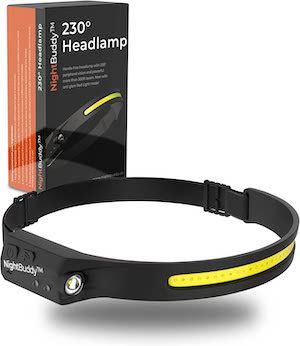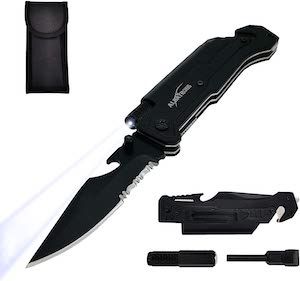
"The 10 Essentials" for Trail Runners
Feb 23, 2023 • 7 minute read
Do you enjoy heading out for long distance trail runs in the wilderness? Trail running up mountains, through the desert or deep in the woods is incredibly fun–but can also be incredibly dangerous. In my favorite trail running playground, White Mountain National Forest, about 20 people die every year (not all trail runners of course), with many others rescued from precarious situations at great risk and great expense.
Many, if not all, of these situations are entirely preventable. They often come down to people simply not being prepared. From getting lost off trail, to running out of water, to getting trapped in a remote location after dark, so many of these tragedies could be prevented with a bit of preparation.
The Ten Essentials
"The 10 Essentials" is a list of 10 items recommended by the National Park Service and many others, that are considered essential to wilderness activities like hiking, camping and trail running, especially in remote areas. It consists of 10 items that can help you survive the unexpected if you run into trouble in the wilderness.
Trail runners like to travel light. So while it might sound like a lot to carry, you'll be amazed to find that there are compact and lightweight options for most items on the list, and you can easily carry them all in a typical trail running vest.
It should be noted that "The 10 Essentials" list is a guideline–you still need to use good judgement and adapt to the specific conditions you'll face. For example, "extra clothes" is open-ended and will require different choices for winter vs summer trail runs. Be sure to consider the season, location and weather conditions before you pack up your vest and set out on a trail run.
With that said, here's the list of 10 essentials, and recommendations for lightweight versions you can add to your trail running kit.
#1 Navigation
"Navigation" is not a single item, but instead a set of tools to help keep you from getting lost.
Having a physical map is a no brainer–it weighs next to nothing, and even if it's only a last resort, you'll be glad you have it. National Geographic makes high quality waterproof, tear-proof maps for national parks and other popular hiking areas. Paired with a simple compass (I use a combined compass and flint firestarter like this), and you'll have most of your emergency navigation needs covered.
You should also familiarize yourself with any navigation capabilities of your running watch. I use a Garmin Forerunner watch for example which has rudimentary compass, mapping and backtracking capabilities. A dedicated GPS device is also an excellent option, though it weighs and costs a bit more.
Finally, it's worth noting while your phone can do navigation, it absolutely cannot be your only navigation resource: phone batteries die, especially during long events in cold conditions.
#2 Headlamp
So many of the rescues in the mountains every year simply come down to a hiker or trail runner moving more slowly than expected and running out of daylight. Having a good light source with long battery life is a must, any time of year.
I personally like these Petzl headlamps, though there are some other cool alternatives out there like this 230 degree headlamp.

As with navigation, do not rely on your phone to be your primary light source. A dedicated headlamp provides far more light with much longer battery life
#3 Sun protection
Sun protection comes in many forms: from sunglasses, to the clothing you wear, to a wide-brimmed hat, to sunscreen. The level of sun protection you need varies greatly depending on the terrain you're tackling, so make sure to do your research.
Where I usually run, in the Northeast, sun is less of an issue than in dessert climates in the West, but I still keep a cheap pair of sunglasses and sunscreen with me in a reusable 3oz silicone container, especially when heading above tree-line.
#4 First aid
Though you hope not to need it, injuries do occur during trail runs. A compact first aid kit is a good idea to bring with you. If you find that the kit is too heavy or the hard case is too bulky, you can repackage the essentials into plastic bags to compact them even further.
As with many other items on this list, exactly how big your kit needs to be is a judgement call–if you plan to be out overnight or in a very remote area, you'll want to make sure you're more prepared.
#5 Knife
A simple knife is an invaluable survival tool for the unexpected. From first aid, to cutting kindling to food preparation, you'll find many uses for a knife in an emergency situation.
There are so many options for knives of all shapes and sizes, and some that have other survival tools like flint, flashlights & screwdrivers built-in.

This is one of the items you may never use–but you'll be glad you have it!
#6 Fire
Being able to start a fire in an emergency situation is crucial. A simple flint & steel firestarter is a good lightweight choice to carry in your pack. Be sure to practice with it before you need it, however: there's an art to starting a fire. You'll also want to keep something easily combustable like a plastic bag of dryer lint.
I also carry a simple Bic Lighter because it's lightweight, far simpler to use and only costs a couple bucks. But carry the flint & steel as a backup: the lighter can easily become useless if it gets wet!
It's worth nothing that you should familiarize yourself with fire safety rules and regulations, especially in places where forest fires are common. Even in an emergency, it's crucial to manage fire responsibly.
#7 Shelter
"Shelter" is an item which sounds like it would be bulky or difficult to take on a trail run, but it can be surprisingly simple! An emergency bivvy weighs about 3oz and can keep you sheltered and warm in the case of an unexpected night in the woods.
The level of shelter you'll need is condition specific, so make sure you find a solution appropriate for the season and location.
#8 Extra Food
There are lots of choices for trail food, but the important thing is to bring much more than you think you'll need. I love these Clif Nut Butter bars and keep several of them in my vest at all times. There are also specifically designed high-calorie survival bars, but I've never tried them.
With a selection of bars and trail mix, you can easily carry around an extra 1,000-2,000 calories which would be crucial in an emergency.
#9 Extra Water
Water is tricky because of course, it's heavy. Water requirements also vary greatly with the conditions, so be extra sure to understand the weather and terrain when deciding how much water to bring. Having a hydration bladder in your vest is always a good idea, even if you also carry handheld bottles as well.
In addition to carrying extra water with you, you should have a strategy for getting water along the way. Always review your route and find where the water sources are, and what kind of treatment they need.
I love the Katadyn collapsable water bottle with integrated filter in the mouthpiece nozzle. All you do is fill up the bottle as usual, and drink directly through the nozzle to get filtered water. And because the bottle is a flexible, collapsible material, it's small & lightweight when not in use.

Finally, I also carry a couple of water purification tablets in case I ever need to purify larger amounts of water and store it in the bladder. I have never, ever used them (and hope not to need to)–but they weigh almost nothing and could come in handy in a pinch!
#10 Extra clothes
Like so many other items on the list, the right choice for "extra clothes" depends on the conditions. But one of my go-to items is a lightweight insulated puffy jacket like this one for this one for women, and this one for men. These jackets weigh only a couple of ounces, and can easily be compressed down to the size of a softball and kept in the running vest.
I often take a jacket like this with me even in warm weather conditions: in the mountains or the desert, temperatures can drop rapidly when the sun goes down, or above tree-line.
In addition to any other clothing, I also carry an emergency mylar blanket in case I find myself in trouble.
Hit the Trails, but Stay Safe
That's the list of The 10 Essentials for trail runners!
Trail running in remote wilderness is truly a primal joy–but it's not without risks. Make sure you're prepared for the conditions & the terrain, starting with the items in this list. As a final reminder, these items on this list are only a starting point: make sure you adapt your pack for the specific conditions you'll be encountering.
Have fun, and stay safe!
This post contains affiliate links for products I personally use & genuinely recommend.